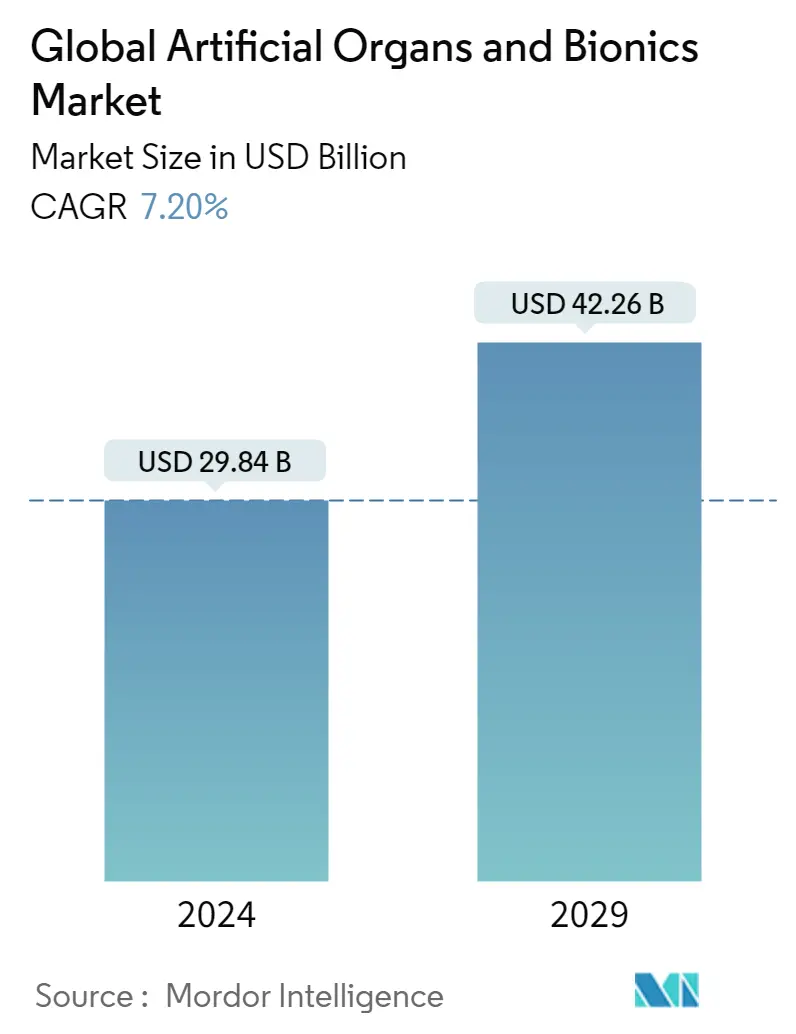Market Size of Global Artificial Organs and Bionics Industry

| Study Period | 2019 - 2029 |
| Market Size (2024) | USD 29.84 Billion |
| Market Size (2029) | USD 42.26 Billion |
| CAGR (2024 - 2029) | 7.20 % |
| Fastest Growing Market | Asia Pacific |
| Largest Market | North America |
Major Players
*Disclaimer: Major Players sorted in no particular order |
Artificial Organs and Bionics Market Analysis
The Global Artificial Organs and Bionics Market size is estimated at USD 29.84 billion in 2024, and is expected to reach USD 42.26 billion by 2029, growing at a CAGR of 7.20% during the forecast period (2024-2029).
The market was impacted adversely during the initial phase of the pandemic due to the lockdowns and strict restrictions, globally. The number of transplants decreased during the initial phase of the pandemic. For instance, as per the article 'The Global Impact of COVID-19 on Solid Organ Transplantation: Two Years into a Pandemic' published in July 2022, over the course of 2020, there was an estimated 16% global decline in transplant activity. Kidney transplant and live donor programs were particularly affected, with significant negative spillover consequences for patients on the waiting list. In addition, as per the source mentioned above, even though the protocols were created and vaccination is undergoing to prevent the patients from the COVID-19 infection, transplant programs and solid organ transplant recipients continue to face challenges. Thus, the studied market was hampered during the pandemic phase. However, there was an increase in kidney diseases and cardiovascular diseases globally during the pandemic. This is anticipated to create demand for organ transplantations, creating opportunities for artificial organs and bionics during the later phase of the pandemic. Thus, COVID-19 has had a significant impact on the studied market.
Factors such as the rising incidence of organ failures, high incidence of road accidents leading to amputations, scarcity of organ donors, and technological advancements are anticipated to drive market growth over the forecast period. For instance, as per the article 'Organ donation in India - There is light at the end of the tunnel' published in April 2022, it is estimated that almost 5 lakh Indians face organ failure every year, and yet less than 2%-3% of them receive a life-saving transplant. This burden of organ failure is anticipated to create opportunities for artificial organs and the bionics market in India. Thus, this is anticipated to contribute to the global artificial organs and bionics market growth over the forecast period.
Moreover, according to the article 'Barriers to the donation of living kidneys for kidney transplantation' published in February 2022, the prevalence of kidney failure is increasing globally among end-stage kidney disease (ESKD) patients, but there is a lack of organ donors in most of the countries globally. Hence, as a kidney transplant is an important alternative for ESKD patients, the demand for artificial kidneys is increasing. This is expected to further fuel the market's growth.
Therefore, owing to the aforementioned factors, the market under study is expected to witness growth over the forecast period. However, strict regulations, compatibility issues, and malfunctions of the products are expected to hinder the market's growth.
Artificial Organs and Bionics Industry Segmentation
As per the scope of the report, artificial organs are mechanical devices that can temporarily or permanently substitute for a body organ. These devices can replicate or augment the natural function of the organ. Bionics refers to the replacement or improvement of body parts by mechanical kinds. The Artificial Organs and Bionics Market is segmented by Type (Artificial Organ and Bionics), and Geography (North America, Europe, Asia-Pacific, Middle East and Africa, and South America). The report offers the value (in USD million) for the above segments.
| By Type | |||||||
| |||||||
|
| Geography | ||||||||
| ||||||||
| ||||||||
| ||||||||
| ||||||||
|
Global Artificial Organs and Bionics Market Size Summary
The artificial organs and bionics market is poised for significant growth over the forecast period, driven by factors such as the increasing incidence of organ failures, road accidents leading to amputations, and technological advancements in the field. The market experienced initial setbacks due to the COVID-19 pandemic, which led to a decline in transplant activities globally. However, the rising prevalence of kidney and cardiovascular diseases during the pandemic has created a demand for organ transplantations, thereby opening opportunities for artificial organs and bionics. The scarcity of organ donors, particularly for kidney transplants, has further fueled the need for artificial kidneys, especially in regions like India, where organ failure rates are high. Despite challenges such as strict regulations and product malfunctions, the market is expected to witness robust growth, with North America anticipated to dominate due to the high incidence of amputations and a growing elderly population.
The global market for artificial organs and bionics is moderately competitive, with key players like Abiomed, Baxter, Boston Scientific Corporation, and Medtronic leading the charge. Innovations such as the Kidney Innovation Accelerator and projects like the advanced artificial heart development in India highlight the ongoing efforts to enhance artificial organ technologies. The demand for artificial organs is further bolstered by the increasing burden of end-stage kidney disease (ESKD) and the need for life-saving transplants. As the prevalence of kidney failure continues to rise, particularly in developed countries, the market for artificial kidneys is expected to expand significantly. This growth is supported by initiatives and collaborations aimed at developing advanced bioartificial organs, ensuring the market's trajectory remains upward over the forecast period.
Global Artificial Organs and Bionics Market Size - Table of Contents
-
1. MARKET DYNAMICS
-
1.1 Market Overview
-
1.2 Market Drivers
-
1.2.1 Increased Incidence of Disabilities and Organ Failures
-
1.2.2 High Incidence of Road Accidents Leading to Amputations
-
1.2.3 Scarcity of Donor Organs
-
1.2.4 Technological Advancements in the Artificial Organ and Bionics
-
-
1.3 Market Restraints
-
1.3.1 Expensive Procedures
-
1.3.2 Compatibility Issues and Malfunctions
-
-
1.4 Porter's Five Force Analysis
-
1.4.1 Threat of New Entrants
-
1.4.2 Bargaining Power of Buyers/Consumers
-
1.4.3 Bargaining Power of Suppliers
-
1.4.4 Threat of Substitute Products
-
1.4.5 Intensity of Competitive Rivalry
-
-
-
2. MARKET SEGMENTATION (Market Size by Value - USD Million)
-
2.1 By Type
-
2.1.1 Artificial Organ
-
2.1.1.1 Artificial Heart
-
2.1.1.2 Artificial Kidney
-
2.1.1.3 Artificial Lungs
-
2.1.1.4 Cochlear Implants
-
2.1.1.5 Other Organ Types
-
-
2.1.2 Bionics
-
2.1.2.1 Vision Bionics
-
2.1.2.2 Ear Bionics
-
2.1.2.3 Orthopedic Bionic
-
2.1.2.4 Cardiac Bionics
-
-
-
2.2 Geography
-
2.2.1 North America
-
2.2.1.1 United States
-
2.2.1.2 Canada
-
2.2.1.3 Mexico
-
-
2.2.2 Europe
-
2.2.2.1 Germany
-
2.2.2.2 United Kingdom
-
2.2.2.3 France
-
2.2.2.4 Italy
-
2.2.2.5 Spain
-
2.2.2.6 Rest of Europe
-
-
2.2.3 Asia-Pacific
-
2.2.3.1 China
-
2.2.3.2 Japan
-
2.2.3.3 India
-
2.2.3.4 Australia
-
2.2.3.5 South Korea
-
2.2.3.6 Rest of Asia-Pacific
-
-
2.2.4 Middle East and Africa
-
2.2.4.1 GCC
-
2.2.4.2 South Africa
-
2.2.4.3 Rest of Middle East and Africa
-
-
2.2.5 South America
-
2.2.5.1 Brazil
-
2.2.5.2 Argentina
-
2.2.5.3 Rest of South America
-
-
-
Global Artificial Organs and Bionics Market Size FAQs
How big is the Global Artificial Organs and Bionics Market?
The Global Artificial Organs and Bionics Market size is expected to reach USD 29.84 billion in 2024 and grow at a CAGR of 7.20% to reach USD 42.26 billion by 2029.
What is the current Global Artificial Organs and Bionics Market size?
In 2024, the Global Artificial Organs and Bionics Market size is expected to reach USD 29.84 billion.

